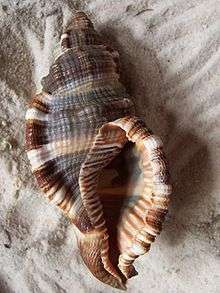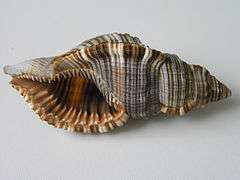Cymatium pileare
| Cymatium (Septa) pileare | |
|---|---|
 | |
| A shell of Cymatium (Septa) pileare with the periostracum removed, anterior end at the bottom | |
| Scientific classification | |
| Kingdom: | Animalia |
| Phylum: | Mollusca |
| Class: | Gastropoda |
| (unranked): | clade Caenogastropoda clade Hypsogastropoda clade Littorinimorpha |
| Superfamily: | Tonnoidea |
| Family: | Ranellidae |
| Genus: | Cymatium |
| Subgenus: | Septa |
| Species: | C. (Septa) pileare |
| Binomial name | |
| Cymatium (Septa) pileare (Linnaeus, 1758) | |
| Synonyms[1] | |
| |
Cymatium (Septa) pileare, common name the hairy triton, is a species of medium-sized predatory sea snail, a marine gastropod mollusk in the family Ranellidae, the tritons.[2]
Subspecies
- Cymatium (Septa) pileare martinianum (Orbigny, 1847)
Distribution
This species is widespread in the Atlantic, in the Red Sea and in the Indo-Western Pacific from East and South Africa, to eastern Polynesia, north to southern Japan and Hawaii and south to southern Queensland.[3][4][5][6]
Habitat
This tropical benthic sea snails can be found at a depth range of 0 – 50 m.[5] They mainly live on hard and coarse detritic bottoms, in coral reef areas.[6]
_pileare.jpg)
Description
Shells of Cymatium pileare can reach a size of 38–140 millimetres (1.5–5.5 in).[3] These large shells are elongate with a tall spire and a strongly inflated body whorl. They show a yellowish-brown surface with chestnut- brown spiral ribs. The columella and the aperture are dark brown with white teeth.[7] The outer sculpture is relatively fine, with long inner ridges of the outer lip, extending deep into the aperture.[6]
Biology
These sea snails are active predators. They are reported as feeding on bivalves. Eggs are laid on the substrate in large capsules clustered in masses.[6]

References
- ↑ Biolib
- ↑ WoRMS : Cymatium pileare (Linnaeus, 1758)
- 1 2 Hardy's Internet Guide to Marine Gastropods
- ↑ Galli C.: WMSDB - Worldwide Mollusc Species Data Base
- 1 2 Sea Life Base
- 1 2 3 4 Cymatium pileare at FAO.org
- ↑ Angeline Myra Keen Sea Shells of Tropical West America: Marine Mollusks from Baja California to Peru
Bibliography
- A.G. Hinton - Shells of New Guinea & Central Pacific
- Abbott, Robert Tucker (1974), American Seashells: The Marine Mollusca of the Atlantic and Pacific Coasts of North America. 2nd ed
- Bernard, P.A. (Ed.) (1984). Coquillages du Gabon [Shells of Gabon]. Pierre A. Bernard: Libreville, Gabon. 140, 75 plates pp.
- Cornelis Swennen, Robert Moolenbeek, N. Ruttanadakul - Molluscs of the Southern Gulf of Thailand
- F. Pinn - Sea Snails of Pondicherry
- G. T. Poppe - Philippine Marine Molluscs Vol. 1
- ITIS: The Integrated Taxonomic Information System. Orrell T. (custodian)
- Ngoc-Thach Nguyên - Shells of Vietnam
- R. Tucker Abbott - Seashells of South East Asia
- Thomas Henning and Jens Hennens - Ranellidae and Personidae of the WorldMarine
| Wikimedia Commons has media related to Cymatium pileare. |